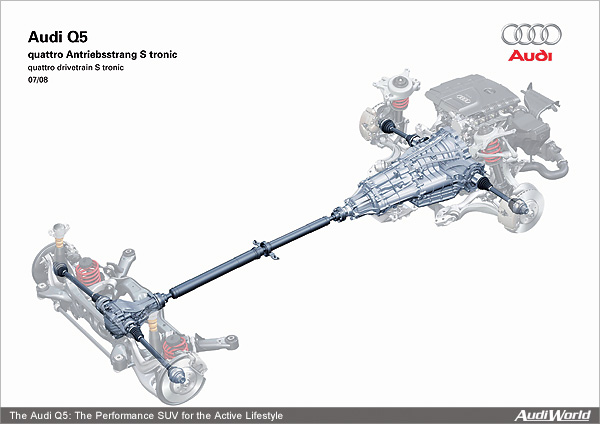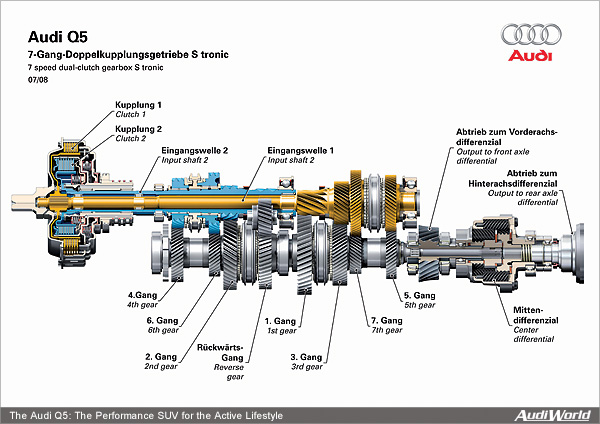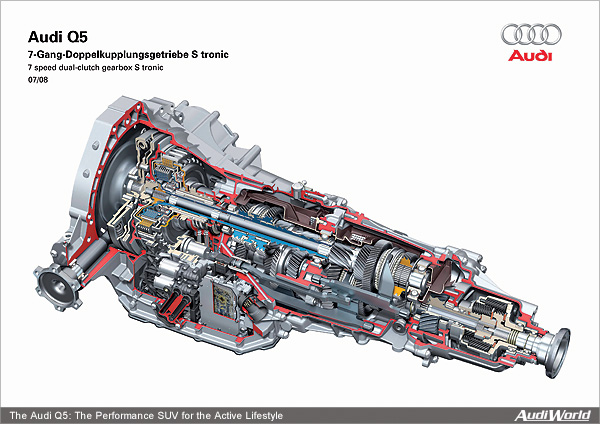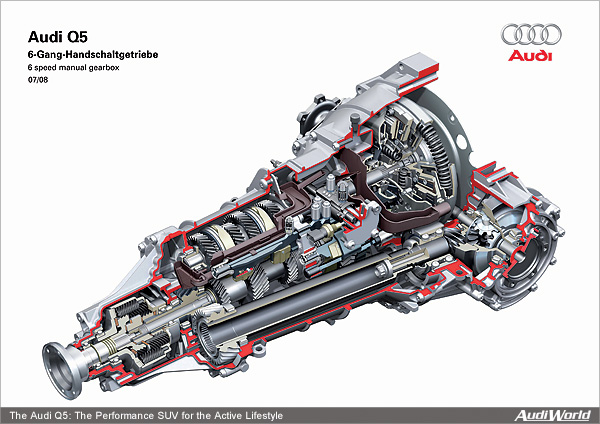Audi Q5: The Drivetrain

The transmission technology is utterly new and innovative: the 3.0 TDI and the 2.0 TFSI have the new seven-speed S tronic as standard; the 2.0 TDI is combined with a six-speed manual transmission as standard. The dual-clutch transmission is a brand new development from Audi, a hi-tech component that is both dynamic and highly efficient.
Audi Q5 drivers can use the new seven-speed S tronic in various modes. The fully automatic mode, in which the control unit determines the gearshifts, offers the D (Drive) and S (Sport) programs. The driver of the Audi Q5 can also change gear manually with the selector lever or with the optional shift paddles on the steering wheel an amazingly fast affair. The gearshift feel is dynamic, comfortable and very precise typically Audi.
The seven-speed S tronic is composed of two transmission structures. It integrates two multi-plate clutches that control different gears. The large K1 clutch located on the outside directs the torque via a solid shaft to the gear wheels for the odd-numbered gears 1, 3, 5 and 7. These are located in the rear section of the cast aluminum transmission casing.
A hollow shaft rotates around the solid shaft. It is connected to the smaller K2 clutch, which is integrated into the inside of its larger sibling, and which controls the gear wheels for the even-numbered gears 2, 4 and 6, as well as reverse gear. All gear wheels are arranged one behind the other on both output shafts, in the order 4, 6, 2, R, 1, 3, 7 and 5.
Both transmission structures are continuously active, but only one is connected to the engine at any one time. For example, when the driver accelerates in third gear, the fourth gear is already engaged in the second transmission structure.
The shifting process takes place as the clutch changes K1 opens and K2 closes. The gear change takes only a few hundredths of a second and is completed without interrupting traction. It is so fluid and smooth that the driver hardly notices it.
The power flows from the output shaft to the self-locking center differential of the quattro drivetrain, which distributes it in two directions. In the basic distribution, 60 percent of the torque flows via the propshaft to the differential for the rear axle, and 40 percent flows via a side shaft to the bevel gear of the front-axle differential. Because this shaft is installed at a 7.2 degree angle, it uses a slanted, beveloid gear. To reduce weight, it is also hollow. When needed, the center differential can deliver up to 85 percent of the power to the rear axle or a maximum of 65 percent of the power to the front axle.
Each component of the new seven-gear S tronic attests to Audi’s uncompromising quality standards. Carbon-coated synchronizer rings guarantee synchronization of unsurpassed quality and stability. The gears one through three and reverse are also designed as three-cone synchronizations.
High-precision management of the two multi-plate clutches was one of the key aspects of the specifications manual. Audi achieved this by means of compact pressure cylinders, electronically controlled speed equalization, and optimized coil spring assemblies. This technological package provides maximum precision and comfort for moving off and shifting.
Transmission manager: the mechatronics
The transmission is managed by the so-called mechatronic module. This module consists of a compact group of control units and hydraulic control valves that is integrated on the left of the transmission, looking in the direction of travel. Its control function allows it to vary the speed of the gear shifting process and to control the power necessary for the process extremely precisely.
The control pressure is generated by an efficiently operating oil pump that is located next to the mechatronic module and is driven by a gear stage. It is supported by a vacuum booster for cooling the dual clutch during starting. This virtually doubles the amount of oil delivered on demand, without any need to increase the power consumption.
Audi has designed the new seven-speed S tronic to provide both exhilarating driving and maximum economy. The new hi-tech unit operates with very high efficiency and its control system maximizes fuel economy in automatic mode. The maximum possible spread of 8.0:1 permits both a sportily short ratio for first gear and a speed-reducing high gearing for the highest gear.
Light and highly efficient: the manual transmission
The manual transmission that always comes with the 2.0 TDI can likewise be described as a hi-tech component. It has a light magnesium casing and belongs to Audi’s new family of transmissions in which two important components have switched position the differential is now in front of the clutch, as on the seven-speed S tronic, in other words directly behind the engine. This arrangement moves the front axle well forward, resulting in a long wheelbase and an ideal axle load distribution.
The drive from the transmission to the differential is handled by a hollow shaft angled at 7.2 degrees with beveloid gearing. The dual-mass flywheel and the hydraulically actuated single dry-plate clutch are not bolted to the crankshaft in the usual way, but supported on the transmission input shaft. Exhaustive fine-tuning has reduced the internal friction, thus further improving the already high level of efficiency. A special mount for the selector forks isolates the gear lever from driveline vibrations.
In the driver’s perception this whole technical package produces that characteristic Audi feeling of ultimate precision the manual six-speed transmission can be shifted easily and smoothly, with short, well-defined travel. The driver information system’s display incorporates a shift indicator. It shows which gear is currently in use, and if that gear has been engaged for a while, it recommends a different gear if that would be a better choice.
All engines in the Audi Q5 bring their power onto the road via quattro permanent all-wheel drive. The enhanced traction, road dynamics, safety and directional stability that it delivers together make up Audi’s proverbial “Vorsprung durch Technik”. The performance SUV handles with unruffled stability whatever the weather, and is also an ideal towing vehicle.
In classic Audi style, a self-locking center differential is at the heart of the drivetrain on the Q5, too. Operation of the self-locking worm gear is purely mechanical, meaning response is instantaneous. Its locking action is only active when the throttle is open; differences in rotational speed are tolerated when the brakes are applied and when cornering. In normal driving conditions, 40 percent of engine power is directed to the front wheels and 60 percent to the rear wheels the result is sporty handling with a rear-driven emphasis.
When needed for instance when the wheels on either axle start to spin on a slippery surface the center differential redirects most of the torque to the axle revolving more slowly and therefore having better traction. Up to 65 percent of the power can be directed to the front wheels and up to 85 percent to the rear this variable distribution enables the Q5 to handle a wide range of situations close to the handling limits without the ESP stabilization system needing to apply the brakes. If one wheel on an axle begins to spin, this is eliminated by the Electronic Differential Lock EDL without any brake application being needed not that such a situation arises very often. EDL also acts as an aid when driving off.
The equipment, data and prices stated here refer to the model range offered for sale in Germany. Subject to amendment; errors and omissions excepted.
|



